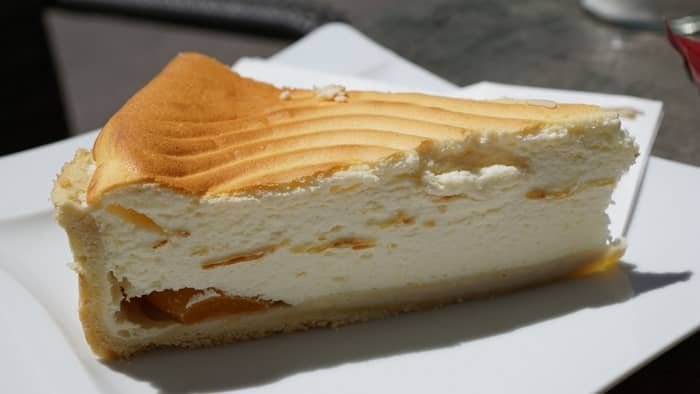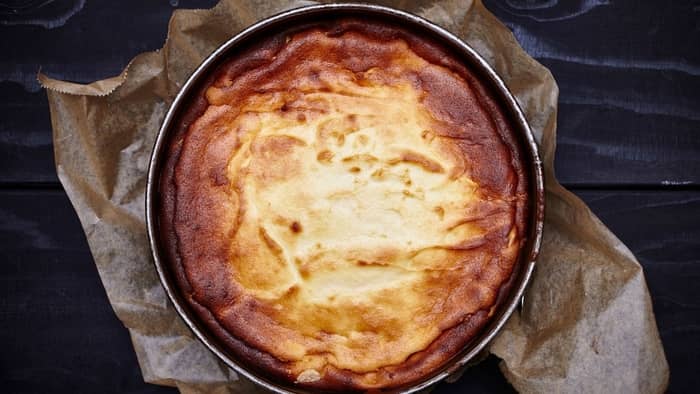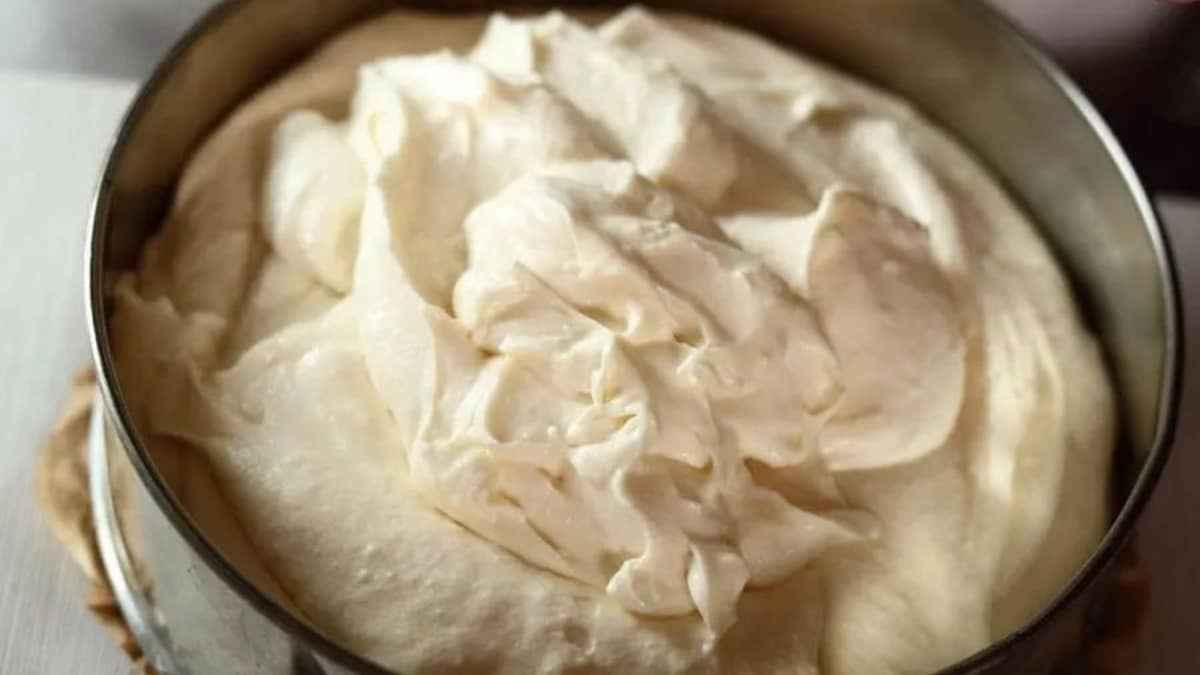By Lindy Van Schalkwyk, last updated on October 6, 2022
What is more frustrating than spending hours making a creamy cheesecake, only to find out it has curdled? So, why did my cheesecake curdle?
There are luckily only a few reasons this happens, all of which are very preventable. It can curdle because you are using bad techniques, overmixing the ingredients, and overbaking the cheesecake. By following our in-depth steps to prevent and fix curdled cheesecake batter, you’ll quickly learn how to make this dessert perfectly every time!
What Is Curdling?
Today, we are jumping straight into it! First, you need to understand what curdling is. Now, most people have already heard of curdling and how it happens. Some of you may have even experienced it firsthand! However, there is more than one way an item can curdle.
Technically, curdling is a process that happens when an emulsion of ingredients breaks. This can happen in a couple of ways and for a couple of reasons. We’ll give you a few common examples that you may not have even realized are technically curdling.
The most common example linked to curdling is when dairy products are combined with an acid like lemon juice. When they are combined, the pH level of the dairy product drops. This causes the acidic and milk proteins to clump together, splitting from their original emulsion with other molecules.
Another example is milk that has been left in the fridge for a little too long. The proteins naturally start to clump together and cause acidic flavors and grainy lumps to develop.

Why Did My Cheesecake Batter Curdle?
So, cheesecakes are naturally very fragile baked goods. When trying to figure out why did my cheesecake curdle, it usually starts with the batter. Cheesecakes are extremely sensitive to overmixing and to sudden or extreme temperature changes. Any one thing can cause the cheesecake batter to curdle.
This causes a lumpy and grainy texture that is very unflattering. We will break down some of the most common reasons that cheesecake batters curdle and when the baked cheesecake curdles.
Ingredient Temperature
Now, naturally, there are thousands of cheesecake recipes you can find online. But, regardless of which one you choose, your ingredients should always be at the same temperature. Getting them to room temperature before mixing them is crucial. When they are at room temperature, they are much easier to mix and create a beautifully smooth emulsion.
If you are, for example, using ice-cold cream cheese, your batter will be lumpy. Then, later on, as the cream cheese softens, it will separate from the other ingredients and cause a curdling effect. The same is especially true when using cold fats like butter.
Incorrectly Adding Ingredients
Some cheesecake recipes call for additional lemon juice to be added to the cream. Now, as we have mentioned before, cream and milk (dairy products) curdle exceptionally quickly when an acidic is introduced. So, when it is done incorrectly and you don’t use the mixture quickly enough, the proteins will clump and cause them to split.
It would be better to completely avoid adding acidic ingredients directly to milk products like cream or dairy.
Read more about Creamy Philadelphia Cheesecake With Oreo Cubes – Step by Step Tutorial

Already Curdled Cream Cheese
You’d be surprised to learn how many people accidentally use curdled cream cheese. Or, unknowingly, curdle the cream cheese itself. This will naturally affect the texture of your baked cheesecake. So, always make sure that your problem isn’t something this avoidable!
Overmixing the Batter
This is one of the most common reasons for cheesecake batters to curdle and split. The cream is a very sensitive ingredient. When it is overworked, it starts to separate. This separation causes the entire emulsion of the batter to break and curdle as well.
Overmixing also incorporates too much air. When the batter is baked, the air pockets expand and create a ton of bubble-like shapes in cheesecake, which often resembles curdled cheesecake. While the cheesecake technically isn’t curdled, these bubbles do create a weak structure and can cause curdle-like characteristics, like a grainy or crumbly texture.
Incorrect Baking
Often cheesecake batters curdle during the baking process. This happens because of two reasons. The first is that the oven temperature was far too hot. The second is that the cheesecake has been overbaked. Some cheesecake recipes, due to the ratios of the ingredients, may cause a curdle-like texture once the cheesecake has been baked. It is always crucial to follow the exact steps of the recipe, but also think about what you know works!

Why Did My Cheesecake Curdle? Tips And Tricks To Prevent It
- Always follow the instructions of the recipe exactly. However, there is an exception to this rule. If you have been making cheesecakes for quite some time, then you know when something in a recipe is strange. For example, if a recipe says to remove the cheesecake to cool at room temperature. You know that sudden temperature changes will cause the cheesecake to crack. If you are new to making cheesecakes, have a look at some of our extremely informative articles on cheesecake tips and tricks.
- Always use room temperature ingredients.
- Do not overmix your batter. Only mix the ingredients until you have a smooth mixture. The room temperature ingredients will help prevent any overmixing.
- Do not overwhip or overmix the cream (if you are using any in your recipe). Only whip the cream until they reach soft to medium peaks.
How To Fix Curdled Cream Cheese?
There aren’t a lot of ways to re-emulsify curdled cream cheese. Now, we first want to emphasize that curdle cream cheese doesn’t necessarily mean that the cream cheese has gone off. Sometimes it only means that the mixture split. Always check the cream cheese for other signs of being bad before tossing this expensive ingredient.
Now, to fix curdled cream cheese, your best option would be to reheat and mix it. You can gently heat the curdles cream cheese over a double boiler while continuously whisking it. This will help bring all of the components to the same temperature and completely remove any lumps.
Once it is smooth, remove it from the heat and allow it to cool down to room temperature while still whisking it.
How To Fix Curdled Cheesecake Batter?
Now, let’s say that somewhere down the line you realize your batter is splitting. There is also only about one way to fix it short of any preventative measures.
Like with the curdled cream cheese, you can try to gently reheat the batter over a double boiler or in short bursts in the microwave. Continuously whisk the batter (gently) to remove any lumps and to re-agitate the bonds back together.
Why Did My Cheesecake Curdle? Final Thoughts
Hopefully, we’ve fully answered the question to “Why did my cheesecake curdle?” But, if you still have any questions or are unsure about anything, feel free to ask us in the comments below. And remember, always use room temperature ingredients, don’t overmix the batter, and never overbake your cheesecake!
FAQs

Lindy Van Schalkwyk is a culinary specialist with a background in Advanced Cooking, Advanced Pâtisserie, Media Communications and Nutrition. She has gained invaluable experience in the culinary industry having worked in some of the top restaurants in Africa in 2016 and 2017. Her expertise in nutrition has enabled her to develop recipes for special dietary needs. In 2018, Lindy began working in the Food Media industry, focusing on recipe development, recipe writing, food writing and food styling.

